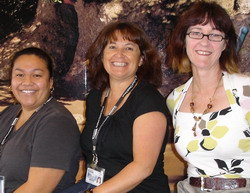An HRC-funded trial to test the effectiveness of the drug azithromycin (AZM) on Māori and Pacific children with bronchiectasis – a type of irreversible scarring in the lungs – has achieved a 50 per cent drop in respiratory infections.
Starship respiratory paediatrician Dr Catherine Byrnes and registered nurse Ms Charmaine Mobberley, researchers with The University of Auckland, carried out the Auckland-based trial over a period of one-to-two years. Forty-two children from Māori and Pacific backgrounds took part in the trial, with some receiving AZM and others receiving a placebo.
Respiratory and infectious diseases are two of the most common causes of hospitalisation in New Zealand children under five years of age. Children tend to get bronchiectasis after suffering from early, repeat respiratory infections that never completely resolve. Over time, the airways within the lung become deformed. This causes a pooling of secretions which are hard for children to clear. The condition is particularly common in Māori and Pacific children.
“We’ve seen children deteriorate throughout their childhood years with increasing numbers of infections. There’s a high rate of death when they reach their early to middle adult years from pneumonia and respiratory failure,” says Dr Byrnes.
A recent study reported in 2011 in South Auckland led by Associate Professor Conroy Wong showed that of all the adults that were hospitalised with bronchiectasis in one year, 46 per cent were readmitted to hospital and 21 per cent (one in five) had died within 12 months.
For this trial, Dr Byrnes and her colleagues collaborated with researchers from Australia and Alaska who conducted similar trials on children from their respective indigenous communities, where cases of bronchiectasis are also very common.
“Overall, compared with the placebo, the weekly doses of AZM achieved a significant 50 per cent decrease in respiratory infections and a 40 per cent decrease in hospital admissions in Aboriginal children in Australia and Māori and Pacific children in New Zealand. However, the effects were greater in New Zealand. Overall, 7 per cent of children receiving AZM were hospitalised by the end of the intervention period, compared with 20 per cent of those receiving the placebo.”
“Children in New Zealand – certainly those in the trial – have more severe bronchiectasis, and perhaps the medicine was more effective because of this. Also, in our trial Charmaine and whānau worker Sara Kake visited the children’s families each week to give the children the medicine and make sure it was taken correctly. This directly observed therapy is far more difficult to do in the rural communities of Australia and Alaska, but it’s really important because it means we can be sure the result is dependent on the medicine,” says Dr Byrnes.
AZM was chosen because it has both antibiotic and anti-inflammatory properties, and could be given to the children once a week compared with traditional antibiotics which have to be taken three times daily, and often result in gastrointestinal side effects.
“These results provide new evidence-based recommendations that a prolonged course of antibiotics can not only make the children’s immediate health better, but also prevent the disease progressing,” says Dr Byrnes.
Ninety-eight per cent of families approached to take part in the New Zealand trial enrolled, with 95 per cent completing the weekly visits for a full year, and 82 per cent for two years. Ms Mobberley says they received significant support with enrolling families from Starship, in particular from Mr John Paterson, director of Kaitawhai, and Ms Hilda Fa’asalele, leader of the Pacific Island family support group.
“At the end of the trial we had a student on a summer studentship interview the families to find out how they found the research. All the families said that they learned a lot about the condition through the weekly visits, and that they felt secure knowing that someone was coming to check how things were going,” says Ms Mobberley.
The research has led to two more international collaborations with Professor Anne Chang from the Queensland Medical Research Institute, Brisbane and Menzies School of Health Research in Darwin, Australia, and Professor Rosalyn Singleton from the Alaska Native Tribal Health Consortium in Anchorage, Alaska.
AZM is now funded in New Zealand for the first time for respiratory illnesses, but, at this stage, only as a short-term treatment option for infections in bronchiectasis.
“We believe this study has shown that in children with problematic bronchiectasis and recurrent infections, the prolonged use of antibiotics, for example, over a whole winter, would also be an excellent treatment,” says Dr Byrnes.
